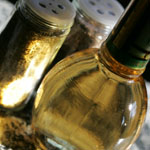
Hand Washing Guide
● Use warm water and a liquid soap.
● Work up a good lather, making sure you wash your wrists, hands, fingers, thumbs, fingernails and in between the fingers.
● Rinse the soap off your hands and dry them thoroughly using disposable towels, not your apron.
● Use the paper towel to turn off the faucet and discard the paper towel in the trash.
Effective cleaning gets rid of bacteria on the hands, equipment and surfaces, helping to stop bacteria from spreading onto foods.
When Should Hands Be Washed
● After taking out the garbage or trash
● After clearing tables or busing dirty dishes
● After touching soiled aprons or clothing
● After touching anything that may contaminate the hands
(any surface not sanitized)
● After sneezing, coughing or using a tissue
● After smoking, eating, drinking or chewing gum or tobacco
● After using any cleaning, polishing or sanitizing chemical
● After using the restroom
● Before and after handling raw food
● After touching the hair, face or body
Hand Hygiene
● Fingernails should be kept short and clean.
● Nail polish, false nails and acrylic nails should not be worn while handling food.
● Cuts and sores should be treated and kept covered with clean bandages.
● If hands or fingers are bandaged, gloves or finger cots should be used to protect the bandage and prevent it from falling into the foods. It may be necessary to move an employee to an area where food will not be handled
Restaurant Owners Need To Provide
Provide a separate handwashing sink; hand drying device, or disposable towels; supply of hand cleaning agent; and waste receptacle for each food preparation area, utensil washing area, and toilet room (required number based on law). Sinks used for food preparation or for washing equipment or utensils shall not be used for handwashing.
Each handwashing sink shall be provided with hot and cold water tempered by means of a mixing valve or a combination faucet to provide water at a temperature of at least 110°F.
Handwashing sinks shall be conveniently located for use by all employees in food preparation and utensil washing areas. Handwashing sinks shall be easily accessible and may not be used for purposes other than handwashing. It is suggested that a handwash sink be located within 25 feet of a work station. Splashguard protection is suggested if adequate spacing to adjoining food, food preparation, food contact surfaces, and utensil washing area surfaces (drainboards) is insufficient. Splash from a handwash sink may not contaminate food, equipment or utensils. A baffle or barrier may be needed if the handsink abuts a food preparation or service surface.
